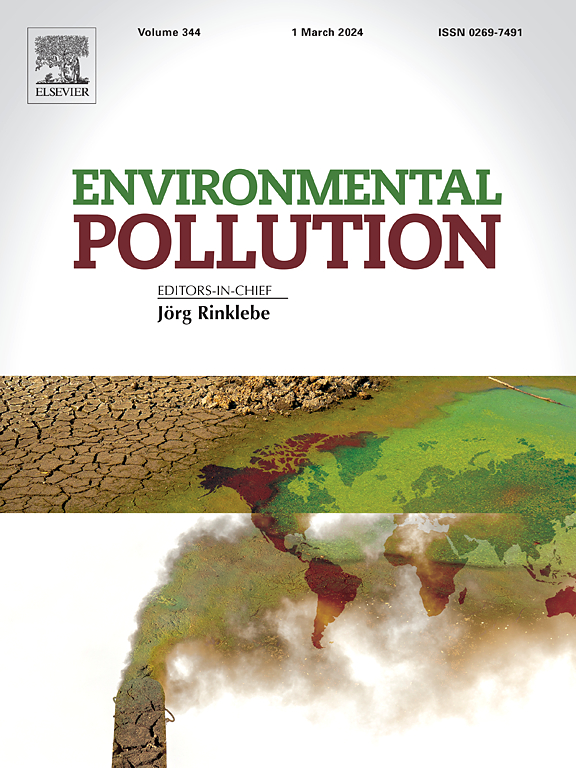对比土壤中菲和苯并芘自然衰减的非生物和生物耗散:系统定量研究
IF 7.6
2区 环境科学与生态学
Q1 ENVIRONMENTAL SCIENCES
引用次数: 0
摘要
通过非生物和生物耗散过程,自然衰减对减少多环芳烃(PAHs)的数量和毒性具有重要的生态系统功能。本研究系统研究了4种土壤中菲(Phe)和苯并[a]芘(BaP)在360 d内的非生物和生物耗散,利用CSIA定量分析了δ1³C的变化和生物降解过程。结果表明,可提取Phe主要通过生物降解方式衰减(65% ~ 81%),4种土壤类型的δ1³C变化范围为2.06‰~ 4.20‰。只有17% -27%的Phe通过形成II型不可提取残留物(ner)消散,而其I型ner仍可用于微生物利用。值得注意的是,微生物属双胞菌和鞘氨单胞菌成为Phe生物耗散的关键贡献者。相反,可提取的BaP主要通过非生物过程衰减(35% - 52%),特别是通过I型和II型ner的形成,较小部分(6% - 17%)通过生物耗散。虽然BaP的δ1³C值变化范围仅为0.76‰~ 1.06‰,但其显著变化(p<0.05)支持微生物对BaP的降解。此外,土壤有机质和pH值影响可提取Phe和残留Phe,而土壤电导率和质地主要影响BaP而不是Phe。这些发现强调了多环芳烃在土壤中自然衰减的多重消散机制,并为多环芳烃污染土壤的修复策略提供了有价值的定量数据。本文章由计算机程序翻译,如有差异,请以英文原文为准。
![Abiotic and Biotic Dissipation in Natural Attenuation of Phenanthrene and Benzo[a]pyrene: A Systematic Quantification Study in Contrasting Soils](https://img.booksci.cn/booksciimg/2025-1/2025012110165945450519.png)
Abiotic and Biotic Dissipation in Natural Attenuation of Phenanthrene and Benzo[a]pyrene: A Systematic Quantification Study in Contrasting Soils
Natural attenuation represents a significant ecosystem function for mitigating the quantity and toxicity of polycyclic aromatic hydrocarbons (PAHs) through both abiotic and biotic dissipation processes. This study systematically investigated abiotic and biotic dissipation of phenanthrene (Phe) and benzo[a]pyrene (BaP) in four soils over 360 days, using CSIA to quantitatively analyze δ1³C changes and demonstrate biodegradation. The results indicated that extractable Phe was primarily attenuated via biodegradation (65% - 81%), as revealed by CSIA, with the δ1³C changes ranging from 2.06‰ to 4.20‰ across the four soil types. Only 17% -27% of Phe dissipated by forming Type II non-extractable residues (NERs), while its Type I NERs remained available for microbial utilization. Notably, the microbial genera Gemmatimonas and Sphingomonas emerged as key contributors to the biotic dissipation of Phe. Conversely, extractable BaP was predominantly attenuated through abiotic process (35% - 52%), particularly via the formation of Type I and Type II NERs, with a smaller fraction (6% - 17%) undergoing biotic dissipation. Although the changes in δ1³C values for BaP were only 0.76‰ -1.06‰, the significant changes (p<0.05) supported the microbial degradation of BaP. Additionally, soil organic matter and pH influenced the extractable and residual Phe, whereas soil electrical conductivity and texture primarily affected BaP rather than Phe. These findings underscore the multiple dissipation mechanisms involved in the natural attenuation of PAHs in soils and offer valuable quantitative data for remediation strategies of PAHs-contaminated soils.
求助全文
通过发布文献求助,成功后即可免费获取论文全文。
去求助
来源期刊

Environmental Pollution
环境科学-环境科学
CiteScore
16.00
自引率
6.70%
发文量
2082
审稿时长
2.9 months
期刊介绍:
Environmental Pollution is an international peer-reviewed journal that publishes high-quality research papers and review articles covering all aspects of environmental pollution and its impacts on ecosystems and human health.
Subject areas include, but are not limited to:
• Sources and occurrences of pollutants that are clearly defined and measured in environmental compartments, food and food-related items, and human bodies;
• Interlinks between contaminant exposure and biological, ecological, and human health effects, including those of climate change;
• Contaminants of emerging concerns (including but not limited to antibiotic resistant microorganisms or genes, microplastics/nanoplastics, electronic wastes, light, and noise) and/or their biological, ecological, or human health effects;
• Laboratory and field studies on the remediation/mitigation of environmental pollution via new techniques and with clear links to biological, ecological, or human health effects;
• Modeling of pollution processes, patterns, or trends that is of clear environmental and/or human health interest;
• New techniques that measure and examine environmental occurrences, transport, behavior, and effects of pollutants within the environment or the laboratory, provided that they can be clearly used to address problems within regional or global environmental compartments.
 求助内容:
求助内容: 应助结果提醒方式:
应助结果提醒方式:


